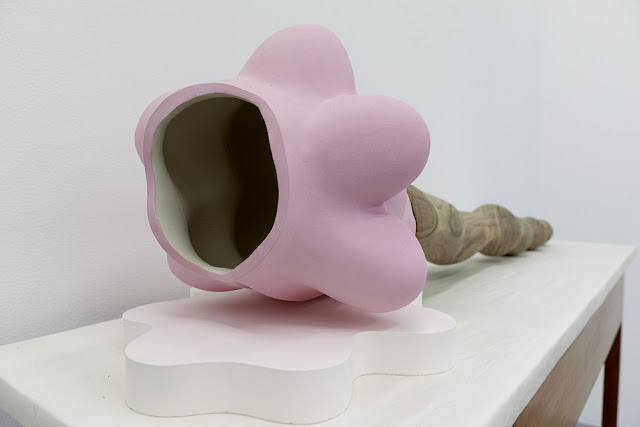 |
Stephen Ralph, 'My Sister's Doll' , 2016. Photo credit: Amanda Williams, courtesy 55 Sydenham Rd |
1. A deep-sea diver is tasked with securing an oil rig to the
North Sea floor. He inserts himself into one of the eight flooded legs of the
platform and descends 120 feet. The man just fits into the metal column, he’s only
able to flinch a centimetre or so either way before striking a wall. There is a
plug at the end of the leg. The diver’s job is to locate the iron chain
attached to the plug and shackle it to the crane poised above. As the man feels
for the chain in the darkness it topples from its perch. It rapidly unfurls onto
his leg, pinning him tight. He is unable to move. His breathing escalates dangerously.
He has no way to communicate with his crew. A leg trapped inside a leg, this is
the first of our eight limbs.
2. A phantom leg is a missing leg, gone, but not erased. It
haunts the body it formerly co-existed with. The body in turn hallucinates its
presence. There is no scientific test to verify the existence of a phantom. The
evidence takes the form of a case study narrative: a first-person account delivered
by the sole witness. An equally subjective phenomenon is the strange leg or
negative phantom: a leg that is present yet absent. Abandoned and disowned by
its body, left off the neural map, the estranged leg has no owner, no general
to issue it orders. A body is able to proceed without a leg, and a leg it seems
is also able to continue on, however uneasily, minus a body.
3. It’s a fallacy that the Victorians covered up their piano
legs for fear of exercising the sexual potency of objects, but it’s a revealing
myth nevertheless. Legs are associated with exposure and shame, with con men
and fake legs used to milk hearts and wallets, with clandestine compartments
for disguising truths. Consider Rolf Harris and his smash hit Jake the peg: kitsch turned creepy: an
exhibitionist’s toe-tapper, a pedophile’s ditty. And Oedipus who slew his
father and slept with his mother having correctly answered the Sphinx’s riddle:
What walks on four legs in the morning, two legs in the afternoon and three in
the evening? (A: man)
4. Historically misfortune has befallen the genders in
different ways. Male legs have been more prone to disarticulation. WW1 and WW2
were periods of mass fragmentation of male limbs while women’s legs, in a telling
echo, were photographed, pinned up and painted onto weapons of mass
destruction. Men, if so inclined, can be ‘leg men’, foot fetishists, stocking afficionados
or amputee enthusiasts. Castration and fetishism: the fear of dismemberment,
and the devotion to objects, or parts, that represent a substitute for any such
loss. Fevered and primarily masculine narratives should you believe in that
sort of thing.
5. A living leg is the stuff of narrative. It regulates movement
from one situation to another. It supports, propels,
conveys; it hops, rests, kicks or shakes itself free. Even a motionless leg is
aligned with a verb as it rests or waits. Single legs are often put to work in a
synedoche, as in pulling a leg, legging it, getting a leg up, or a leg in, or a
leg over: a
leg standing in for an intention, an agent
standing in for a drama.
6. A leg can morph into a thing: an object, a relic, a
specimen. Once separated from its body, a part becomes abject: repudiated,
uncanny, a source of horror. A replicated body part, such as a leg, retains
some of this frisson but evades the full force of the horror, avoiding its
clutches, suggests Julia Kristeva’s Powers
of horror, by cloaking itself in the same garb. A leg in the process of
becoming a thing is perhaps then engaged in a disrobing: a stripping away of all
coverings including those of office.
7. Prostheses and phantoms form a symbiotic pair. Successful
use of a prosthetic leg can be determined by the intensity of its corresponding
phantom. The pain and the discomfort of the missing limb are nerve signals that
can be harnessed to control its replacement. The prosthesis is then able to
lessen the ache of the phantom by rewiring its loss. In a sympathetic doubling
each takes a turn in the other’s place: the phantom becomes the prosthesis, and
the prosthesis becomes the phantom.
8. Legs are sociable structures, dependent on their fellows as
well as the community bonds between feet, ankles and knees. Multiple legs are also
able to operate in unison: witness an eight-legged spider, or an octopus, or a phalanx
of scuba divers’ legs artfully kicking down to the ocean’s depths to extract its
fuel, playing out the precarious balance between subject and thing, between part
and whole, between life and its imminent severing.
Lynne
Barwick, September 2016 (with thanks to Nick Strike)
Hany Armanious, Tully Arnot, Mitch Cairns, Lucas Ihlein, Stephen Ralph, Nick Strike & what. 55 Sydenham Rd, Sydenham, 9-25 September, 2016. Curated by Nick Strike.
http://www.55sydenhamrd.com/un-leg
http://www.55sydenhamrd.com/un-leg